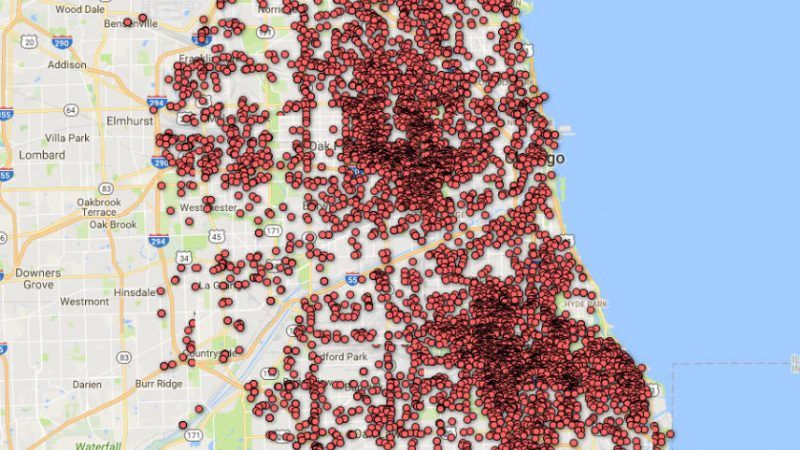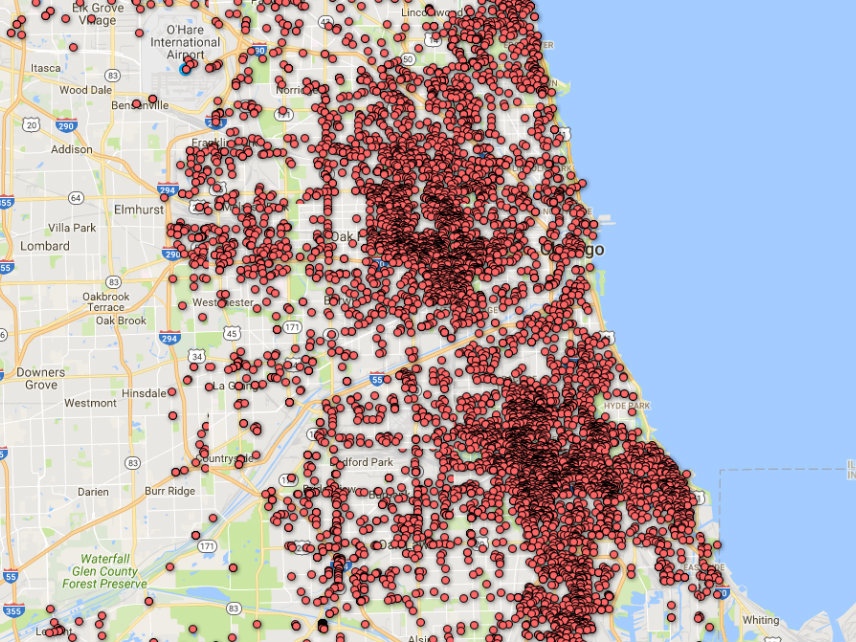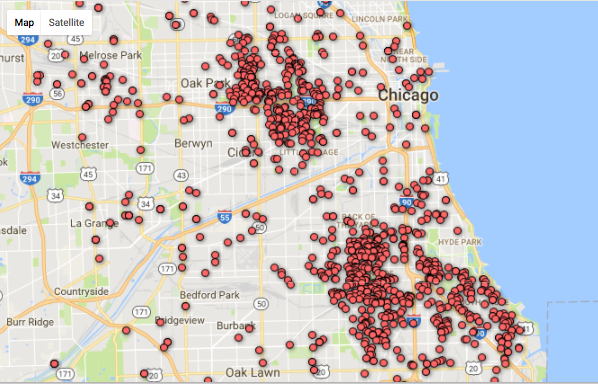Poor Neighborhoods Hit Hardest by Asset Forfeiture in Chicago, Data Shows
Here's a map of 23,000 times over the past five years that police in Cook County seized property and cash.


Police in Chicago and its surrounding suburbs seized $150 million over the past five years. Those seizures were heaviest in low-income neighborhoods, according to public records.
Law enforcement in Cook County, which includes Chicago, seized items from residents ranging from a cashier's check for 34 cents to a 2010 Rolls Royce Ghost with an estimated value of more than $200,000. They also seized Xbox controllers, televisions, nunchucks, 12 cans of peas, a pair of rhinestone cufflinks, and a bayonet.
Altogether, police in Cook County performed 23,065 seizures between 2012 and 2017 using asset forfeiture, including 5,939 vehicles. Chevrolet Impalas, among the most popular rental cars in the U.S., were the model most often seized. About three-quarters of all seizures occurred in Chicago. The average estimated value of a seizure was $4,553, while the median value was $1,049. About three-quarters of all seizures were cash, not property.
Lucy Parsons Labs, a police accountability nonprofit in Chicago, obtained the data from the Cook County State's Attorney's Office (CCSAO) through a public records request and provided them to Reason. The data are unique because they include not just when and what police seized, but addresses of where those seizures occurred.
Civil liberties groups have often claimed asset forfeiture disproportionately impacts poor and minority communities. When these police seizure locations are mapped, it shows that, although seizures happened nearly everywhere in Chicago and the surrounding area, low-income neighborhoods like the South Side and West Side were more frequently the targets of asset forfeiture.
"This data shows what we already know, that the seizures tried by CCSAO overwhelming steal the possessions of poor people," Lucy Parsons Labs says in a statement to Reason. "The data shows that the seizures are clumped in the South and West side, overwhelmingly African-American neighborhoods. This provides more evidence that the war on drugs is a racist policy that must be ended."
Under asset forfeiture laws, police can seize property connected to a crime. However, civil asset forfeiture also allow police and prosecutors to take property on the mere suspicion that it is connected to criminal activity, even if the property owner is never convicted or charged with an offense.
Law enforcement groups say asset forfeiture is an essential tool for disrupting lucrative criminal operations like drug trafficking. However, civil liberties groups—such as the Institute for Justice, a nonprofit law firm that has challenged civil forfeiture laws in several states—say it creates perverse profit incentives, since forfeiture revenue often goes right back into the budgets district attorney offices and police departments.
In Illinois, police and state prosecutors keep up to 90 percent of asset forfeiture revenue. The Institute for Justice gave the state's asset forfeiture laws a "D-" grade for their lax property owner protections, low standards of evidence and expensive bond requirements to challenge seizures.
Those profit incentives and lack of safeguards, civil liberties groups contend, lead police to fish for petty seizures. For example, roughly 11,000 seizures in Cook County over the five-year period were for amounts lower than $1,000. Nearly 1,500 were for amounts under $100.
Filtering out higher dollar amounts shows those petty seizures were even more tightly clustered in the South and West Side of Chicago. Here is what the map looks like when seizures over $100 are excluded:

While the list of seized items contains common tools of the drug trade such as safes, digital scales, and money counters, it also contains things like flashy jewelry, flatscreen TVs, and a copy of the Call of Duty: Ghosts video game.
"Not only has law enforcement in Chicago snatched a staggering amount of money through forfeiture in recent years, much of what they have taken is small-dollar properties," Dick Carpenter, director of strategic research for the Institute for Justice, says of the data. "Despite claims by forfeiture proponents, this is hardly the stuff of vast drug networks and crime bosses."
The pattern of seizures being clustered in lower-income neighborhoods is consistent at a smaller, block-by-block level as well, says Hilary Gowins, content director at the Illinois Policy Institute, a conservative policy think-tank that supports legislation in Illinois to tighten rules for asset forfeiture.
"The North Side is known for being the affluent side, but one of the only neighborhoods that's not as well-to-do is Rogers Park," Gowins says. "It's got a lot of problems with crime. In that area, you'll see a lot of dots."
The CCSAO declined to pursue forfeiture in about 2,100 of the 23,000 cases brought to it by law enforcement. Of the estimated $150 million seized by police over the five-year period, only $47 million was officially forfeited into state custody. The forfeiture process can be slow, another problem area with the law. As the Illinois Policy Institute notes, Illinois state law allows for up to 187 days before a forfeiture hearing is required to take place.
One major caveat to the data is they do not distinguish between civil and criminal asset forfeiture, making it impossible to say how many of those seizures were connected to criminal convictions. On the federal level, civil forfeitures make up the overwhelming majority of cases. According to the Institute for Justice, only 13 percent of Department of Justice forfeitures from 1997 to 2013 were criminal forfeitures, while 87 percent were civil.
"It's unclear whether the bulk of seizures are criminal or civil," Gowins says, "but a concern to keep in mind is that in low-income areas like these, asset forfeiture harms residents acutely because many don't have the means to challenge property seizures."
Under Illinois' drug and money laundering laws, authorities can administratively forfeit seized property without any court proceedings if the owner fails to file a challenge within 45 days and posts a bond equal to 10 percent of the value of the seized property.
The lack of concrete data regarding how police use asset forfeiture is a common problem throughout the U.S. Earlier this year, the Institute for Justice released a report finding the majority of states had little to no transparency requirements surrounding asset forfeiture.
"This data has been kept by CCSAO for many years, in electronic format and should be published routinely," Lucy Parsons Lab says. "It has taken several month of digging and a few attempts to get the CCSAO to release this data, which should not be the case for such a controversial topic as civil asset forfeiture."
An investigation by Chicago Reader last year found the Chicago Police Department raked in $72 million since 2009 in civil forfeiture revenues, using it as an off-the-books revenue stream to fund surveillance activities for its narcotics unit.
Overall, Illinois law enforcement seized $319 million between 2005 and 2015, according to a joint report by the Illinois ACLU and the Illinois Policy Institute.
Last April, the Chicago Tribune ran a lead editorial calling on the state to reform the program. "We've heard too many stories of people whose assets were seized and felt they had no reasonable recourse," the paper's editorial board wrote. "That's no way for citizens to be treated by their government."
One of those stories reported by the Tribune was the case of Judy Weise:
Judy Wiese, a grandmother from Rock Island County, had her 2009 Jeep Compass seized last year after she lent it to her grandson, who was then arrested on charges of driving on a revoked license. Rock Island authorities took the car and refused to return it to the woman, arguing it had been used in the commission of a crime.
The 70-year-old woman, who said she did not know her grandson didn't have a valid license, represented herself in court, where she struggled to understand the legal process and was ridiculed by the judge for not having an attorney, according to local news reports. After reading about her plight, a local lawyer offered to represent her for free because property owners involved in seizure cases are not entitled to public defenders. The car was eventually returned five months after her grandson's arrest.
The Illinois chapter of the American Civil Liberties Union and the Illinois Policy Institute have also both pressed for tightening the rules for asset forfeiture and increase police transparency, but those reform bills have all been stymied over the past few years by the ongoing budget impasse in the state legislature.
While the story the map shows—that low-income neighborhoods are more often the target of asset forfeiture—has long been told through anecdotes, the map is the first time it's been able to be shown at scale with hard data.
"It's a bigger representation of something that nobody would be surprised by," Gowins says, "but everyone should be thinking about."
The Cook County State's Attorney's Office was not immediately available for comment, as it was still reviewing the data as of press time.


Show Comments (63)